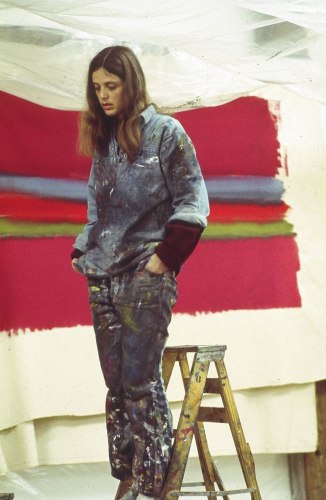

Pat Lipsky in her Hoosick Falls studio, 1971. Photo credit: Joel Lipsky.
B. NEW YORK, NY, 1941
Born in 1941 in New York, Pat Lipsky became associated with the Lyrical Abstraction movement in the late 1960s and ‘70s. The artist moved beyond that style over the course of her career, exploring color field painting and venturing into what Clement Greenberg—the legendary critic and her longtime friend—described as “close-value color.” Throughout her five-decade practice, Lipsky has remained dedicated to the primacy of color and abstraction to the medium of painting.
A painter and writer, Lipsky in her oeuvre has mined a wide range of visual, literary, and musical sources—drawing inspiration from Josef Albers, Jackson Pollock, Mark Rothko, Morris Louis, Marcel Proust, T.S. Eliot, Bach, and Thelonious Monk, among others. Lipsky focuses on how each decisive element in the works of these historic figures affects the whole. As she explains: “When Albers puts a white next to a yellow, the yellow is changed—and the white is changed too. ... We look at works of art as single large units—but they're actually composed of hundreds, of thousands of individual and tiny units, each one a decision. It's those units that I've been experimenting with throughout my career.”
After receiving a B.F.A. from Cornell University in 1963, Lipsky in 1968 earned an M.F.A. from Hunter College where she studied with canonical artist Tony Smith. Lipsky spent the summer of 1969 only ten minutes down the road from the home of Jackson Pollock and Lee Krasner in East Hampton, where she met Krasner. A formative moment, it was during this period that Lipsky conceived her first “wave” paintings. Soaking raw canvas with water, the artist then applied paint by “dancing and playing” (in her words). Drips, splatters, and smears define this early body of work, in which the gesture is paramount. The edges of each canvas in particular pay homage to Pollock’s drip paintings. These vibrant, sinuous paintings are imbued with the energy with which they were made. As critic Carter Ratcliff wrote, “Lipsky emerged in the forefront of a generation of painters… Each of these paintings draws us into the extended exuberant moment of its creation—intuiting the artist’s power to reconcile uninhabited spontaneity with disciplined judgement.”
Less than a year after that transformative summer, Lipsky debuted her work in a 1970 solo exhibition at André Emmerich Gallery, New York. She subsequently participated in the landmark exhibition Lyric Abstraction, which traveled in 1970–1 from the Aldrich Contemporary Art Museum, Ridgefield to the Phoenix Art Museum to the Whitney Museum of American Art, New York. Yet by the late 1970s and ‘80s, Lipsky had turned away from the Lyrical Abstract style, embracing close-value color and geometric shapes as exemplified by her counterpoint grid paintings. Over the decades, Lipsky’s color concerns have shifted as the artist has refined her practice—moving from the bold, high-key hues of her early canvases; to a more subtle and sometimes moody palette; and, finally, to the pigments of her most recent paintings, about which writer Cate McQuaid remarked: “Lipsky is primarily a colorist… These are breathing, organic works, dressed in the clothing of geometric abstraction.”
Lipsky’s work has been widely exhibited and is represented in public collections such as the Brooklyn Museum, Brooklyn, NY; Harvard Art Museums, Cambridge, MA; Hirshhorn Museum and Sculpture Garden, Washington, D.C.; San Francisco Museum of Modern Art, San Francisco, CA; and the Whitney Museum of American Art, New York, NY.